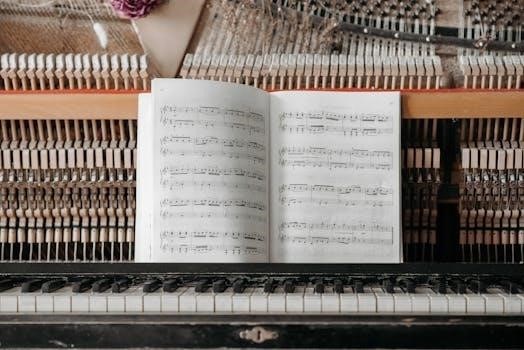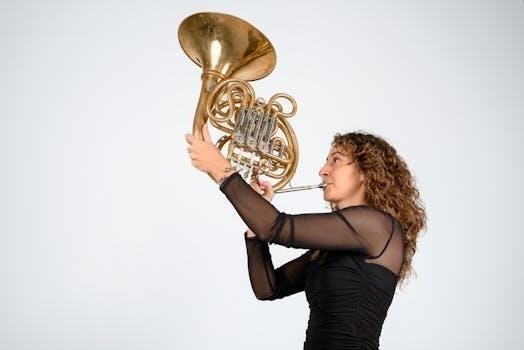
Oskar Böhme⁚ Trumpet Concerto Overview
Oskar Böhme’s Trumpet Concerto, Op. 18, stands as a unique piece within the Romantic era, notable as the only known full-fledged concerto for trumpet from that period. Originally composed in E minor, it was intended for the A trumpet, a now-obsolete instrument. This has led to modern performances utilizing the B-flat trumpet, transposed to F minor. The concerto is known for its melodic beauty and virtuoso demands.
Oskar Böhme, a German-Russian trumpeter and composer born in 1870, is a significant figure in the history of the trumpet. He is primarily known for composing the only full-length Romantic-era trumpet concerto, a work that has secured his place in the brass repertoire. Böhme’s concerto, designated as Op. 18, was originally written in E minor for the trumpet in A, an instrument that gradually fell out of favor; The concerto is a testament to Böhme’s deep understanding of the trumpet’s capabilities, showcasing both its lyrical qualities and its technical prowess. The work is often compared to Mendelssohn’s E minor violin concerto in terms of its structure and overall musical aesthetic. It stands out as a vital contribution to the relatively limited repertoire of solo trumpet concertos from the Romantic period. Böhme’s compositional style leans heavily into the Romantic idiom, emphasizing expressive melodies and rich harmonic language. Alongside his concerto, Böhme also produced other notable works, particularly for brass ensembles, further solidifying his reputation as a composer with a keen understanding of brass instruments. The concerto’s enduring popularity is a testament to its inherent musical quality and its significance as a unique historical artifact.

Historical Context of the Concerto
Oskar Böhme composed his Trumpet Concerto, Op. 18, during a period when the trumpet was undergoing significant development. The late 19th century saw the transition from natural trumpets to valved instruments, expanding the trumpet’s technical possibilities and expressive range. Böhme, as a skilled trumpeter himself, was deeply aware of these advancements and crafted a concerto that exploited the instrument’s newfound capabilities. The Romantic era, in which the concerto was composed, was characterized by an emphasis on emotional expression, melodic beauty, and virtuosity. Böhme’s concerto embodies these qualities, reflecting the prevailing musical trends of the time. While many composers were focusing on other instruments, Böhme’s dedication to the trumpet resulted in this crucial contribution to the trumpet repertoire. It is notable that the trumpet had not been a prominent solo instrument before this time, making this concerto a significant stride for the instrument. The work provides a crucial bridge in the development of the solo trumpet repertoire, filling a noticeable gap during the Romantic era. The concerto’s creation is also tied to Böhme’s personal journey, moving from his German origins to Russia, where he spent most of his career.

Compositional Details
The concerto was originally written in E minor for trumpet in A, but is now commonly performed in F minor using a B-flat trumpet. It features three movements, showcasing the trumpet’s lyrical and technical capabilities. The orchestration highlights the romantic style.
Key and Original Instrumentation
Oskar Böhme’s Trumpet Concerto, Op. 18, was initially conceived in the key of E minor. This choice of key was directly linked to the original intended instrument⁚ the trumpet in A. The trumpet in A, a now largely obsolete instrument, possessed a unique timbre and tonal character that Böhme specifically wrote for. This original instrumentation, with the trumpet in A, was fundamental to Böhme’s compositional vision for the concerto. The E minor key likely influenced the overall mood and harmonic language of the piece, contributing to its Romantic character. The concerto’s melodies and virtuosic passages were all crafted with the specific tonal qualities of the A trumpet in mind. The historical context of the A trumpet’s use in the late 19th century is also important in understanding Böhme’s original intent. The shift to performing the concerto on the B-flat trumpet and consequently in F minor is a modern adaptation due to the practical limitations of using the original instrument today. The original key and instrumentation are essential elements in understanding the historical context of Böhme’s concerto. The original score provides a glimpse into the composer’s intentions when writing for the A trumpet and its specific tonal characteristics.
Movements of the Concerto
Oskar Böhme’s Trumpet Concerto, Op. 18, is structured in the traditional three-movement format, a common practice during the Romantic era. The first movement, typically marked “Allegro moderato,” presents the main themes of the concerto and establishes the overall character of the work. It is characterized by its melodic nature and virtuosic passages for the trumpet. The second movement, often designated as “Adagio religioso” or “Allegretto,” provides a contrasting slower tempo and a more lyrical expression, allowing for the trumpet to showcase its expressive capabilities. This movement often features a more reflective and introspective mood. The third and final movement, marked “Rondo. Allegro scherzando,” concludes the concerto with a fast and energetic pace. It is typically lighthearted and technically challenging, with the rondo form creating a sense of return to the main theme throughout the movement. The interplay between the soloist and the orchestra is a key element in each movement, with both partners playing equally important roles in the overall musical narrative. This three-movement structure provides a balanced and contrasting musical experience, showcasing the different facets of the trumpet and the composer’s musical language.
Orchestration and Arrangements
The original orchestration of Oskar Böhme’s Trumpet Concerto, Op. 18, was designed for a standard Romantic-era orchestra, featuring a complement of strings, woodwinds, and brass, providing a rich and varied tonal palette. However, details about the precise instrumentation of the original score are not widely available in the provided context. Given the concerto’s popularity and the practical needs of performance, several arrangements have emerged. A common arrangement is for trumpet and piano, which serves as a useful tool for practice and study, as well as for performances in settings where a full orchestra is not available. Furthermore, some modern orchestrations have been created, such as the one by Matthias Höfs, which aim to bring the concerto to larger audiences and showcase the virtuosic possibilities of the trumpet. The availability of arrangements for wind ensemble, further demonstrates the adaptability and widespread appeal of this concerto beyond its original orchestral setting. These various arrangements allow for the concerto to be performed in various settings, ensuring its continued presence in the trumpet repertoire.

Performance and Editions
The Böhme Trumpet Concerto, originally in E minor, is now typically performed in F minor due to the shift to the B-flat trumpet. Numerous piano reductions and editions exist, facilitating practice and performance. Notable recordings and performers have popularized this work.
Transition to F Minor and B-flat Trumpet
The original conception of Oskar Böhme’s Trumpet Concerto was in the key of E minor, specifically tailored for the now rarely used A trumpet. This was a common practice during the late 19th century, when instruments were often keyed in various pitches to accommodate different tonal qualities and ensemble needs. However, as the A trumpet gradually faded into obsolescence by the mid-20th century, a practical problem arose for performers wishing to tackle Böhme’s work. The solution was found in transposing the concerto to the key of F minor, a semitone lower. This adaptation allowed the piece to be played on the more ubiquitous B-flat trumpet, the standard instrument for most modern orchestral and solo trumpet playing. This transition was crucial for the continued performance and preservation of Böhme’s concerto, making it accessible to a wider range of musicians and audiences. This shift also necessitated adjustments in printed scores and parts, as publishers began creating editions specifically for the B-flat trumpet. The key change, while seemingly minor, altered the tonal landscape of the piece slightly, yet it allowed a continuation of a significant piece of trumpet repertoire. This adaptation has solidified the concerto’s place in the canon and ensured its continued relevance. The transposition to F minor and the use of the B-flat trumpet is now the standard practice for performing Böhme’s concerto, a testament to the adaptability of music.
Available Editions and Piano Reductions
Due to the original orchestration of Böhme’s Trumpet Concerto for full orchestra, the availability of piano reductions has become essential for both practice and performance purposes. Numerous editions of the concerto have been published, catering to the widespread use of the B-flat trumpet. These piano reductions serve as an invaluable tool for soloists when rehearsing the piece, as they provide a complete harmonic context in a condensed format. These editions usually include both the solo trumpet part in F minor, transposed from the original E minor, and a fully realized piano accompaniment that captures the essence of the orchestral texture. Various publishers, including notable houses such as Anton J. Benjamin and Simrock, have released their own versions of the piano reduction, often with subtle differences in articulation and interpretation suggestions. The availability of multiple editions allows performers to select a version that best suits their needs and preferences. Furthermore, some editions incorporate editorial markings and suggestions from renowned trumpet players and pedagogues, offering additional insights into the performance practices of the concerto. These reductions are not merely simplified versions; they are carefully crafted to maintain the musical integrity of the original orchestral score. Piano reductions have played a crucial role in making the concerto accessible for study, practice, and performance in a variety of settings, especially when a full orchestra is not feasible. They ensure the continued popularity and accessibility of Böhme’s work for future generations of trumpet players.
Notable Recordings and Performers
The Böhme Trumpet Concerto has been championed by numerous renowned trumpet players, leading to a variety of notable recordings that showcase the piece’s versatility and expressive potential. Among these recordings, Matthias Höfs stands out for his technically stunning and artistically nuanced rendition, often performing his own orchestration of the concerto. His interpretation is lauded for its controlled precision, graceful articulation, and nonchalant brilliance, especially evident in the cadenza. Max Sommerhalder’s recording with the Berlin Radio Symphony is also considered a significant contribution, showcasing the concerto in its transposed F minor setting. Other notable trumpet soloists, such as Sergei Nakariakov, have also recorded the concerto, each bringing their unique approach and understanding to the piece, highlighting its rich melodic content and virtuosic demands. These recorded performances not only preserve the concerto for future generations but also serve as valuable resources for aspiring trumpet players. The availability of diverse interpretations allows listeners to appreciate the multifaceted nature of Böhme’s work and its enduring appeal. Furthermore, live performances by accomplished Italian trumpet players like Marco Pierobon contribute to the concerto’s ongoing exposure and influence. These performances, both recorded and live, solidify the concerto’s place in the standard repertoire for trumpet and continue to inspire new generations of performers to explore this exceptional work.

Analysis and Reception
Böhme’s Trumpet Concerto holds a unique position in the Romantic trumpet repertoire, being the only full-length concerto from that era. Its aesthetic qualities and technical demands contribute to its significance. The concerto continues to be analyzed and performed, ensuring its legacy.
Significance within the Romantic Trumpet Repertoire
Oskar Böhme’s Trumpet Concerto, Op. 18, occupies an extraordinary position within the Romantic trumpet literature. It stands out as the sole full-fledged concerto for trumpet from the 19th century, a period not generally known for its solo trumpet works. This singular status elevates its importance, making it a cornerstone of the trumpet repertoire. Unlike the Baroque era, which featured numerous trumpet concertos, the Romantic period largely neglected the instrument in this context. Böhme’s concerto, therefore, fills a void, providing a significant contribution to the limited selection of Romantic trumpet concertos. Its melodic richness, technical demands, and overall structure contribute to its lasting appeal. The concerto’s unique position underscores Böhme’s ingenuity, as it embodies the spirit of Romanticism while addressing the instrument’s potential. The work’s enduring popularity serves as a testament to its intrinsic musical value and historical importance. It has become a crucial work for trumpet players, offering both artistic and technical challenges. The concerto’s influence extends beyond the trumpet world, serving as an example of late Romantic composition. It also highlights the potential for soloistic expression within brass instruments during this period. Böhme’s contribution is vital for the trumpet, providing a piece of significant depth and importance.
Aesthetic Analysis
Böhme’s Trumpet Concerto showcases a compelling aesthetic rooted in the late Romantic tradition. The concerto’s melodic lines are imbued with a sense of lyrical beauty, characteristic of the era, while also demonstrating virtuosity; The work is marked by its balance between expressive passages and technically demanding sections, creating a dynamic interplay that captivates the listener. Its harmonic language is rich and often chromatic, adding depth and emotional nuance. The concerto also exhibits a clear sense of form, with well-defined movements that contribute to its overall coherence. The use of contrasting moods within each movement creates a captivating musical journey. The first movement presents an energetic and heroic character, while the second offers a more introspective and lyrical feel. The finale is bright and exuberant, bringing the work to a spirited conclusion. Böhme’s skillful orchestration enhances the expressive power of the concerto, creating a rich and varied soundscape. The concerto’s aesthetic is one of refined elegance and passionate expression, reflecting the Romantic ideals of beauty and emotional depth. The work’s unique combination of melodic charm and technical brilliance solidifies its place as a significant contribution to the trumpet repertoire.
Influence and Legacy
Böhme’s Trumpet Concerto holds a unique place in the trumpet repertoire, exerting considerable influence due to its status as the only full-scale Romantic concerto for the instrument. Its existence has broadened the possibilities for trumpet players, offering them a substantial work from a period not typically associated with solo trumpet concertos. The concerto’s popularity has encouraged the exploration of similar works, although few match its scope and ambition. It has served as an inspiration for contemporary composers to consider the trumpet as a solo instrument capable of both virtuosic display and deep emotional expression. The work’s legacy is also tied to its adaptation from the original A trumpet to the B-flat trumpet, which ensured its continued performance and relevance in the modern era. This act of adapting also highlights the concerto’s enduring appeal, transcending the instrument for which it was originally conceived. The concerto’s enduring popularity is evident in numerous recordings and performances by leading trumpet soloists, solidifying its position as a standard in the trumpet literature. Its inclusion in educational programs for aspiring musicians further ensures its influence on future generations. The concerto’s legacy continues to grow, and its importance within the trumpet world is secure.